Direct Hydrothermal Synthesis and Characterization of Zr–Ce-Incorporated SBA-15 Catalysts for the Pyrolysis Reaction of Algal Biomass
Abstract
:1. Introduction
2. Materials and Methods
2.1. Materials
2.2. Preparation of Zeolite Catalysts
2.3. Physico-Chemical Characterization of the Prepared Catalysts
2.4. Microalgae Cultivation and Biomass Harvesting
2.5. The Pyrolysis Reaction
2.6. Analysis of the Pyrolysis Products
3. Results and Discussions
3.1. Preparation and Characterization of the Catalysts
3.2. Characterization of Catalytic Pyrolysis Products
- 3358 cm−1: Stretching vibration of the associated O-H.
- 1648 cm−1: Binding vibration of water molecules.
- 1016–1031 cm−1: Asymmetrical tension vibration of the Si-O-Si link.
- 870 cm−1: Symmetrical tension vibration of the SI-O-Si link.
- 559 cm−1: Deformation vibration of the SI-O-Si connection.
- 2968 cm−1: Link tension vibration C-H (of groups CH3).
- 2926 cm−1: Asymmetrical tension vibration of the C-H link (of groups CH2).
- 2853 cm−1: Symmetrical tension vibration of the C-H link (of groups CH2).
- 945 cm−1: Si-O-Zr linkage tension vibration (shoulder).
- 667 cm−1: Zr-O H linkage tension vibration
- 454 cm−1: Tension vibration of the connection.
- 420 cm−1: Zr-O linkage tension vibration.
- 1740 cm−1: Bonding of tension vibration C=O;
- 1556 cm−1: Bonding of tension vibration C=C aromatic;
4. Conclusions
Author Contributions
Funding
Data Availability Statement
Acknowledgments
Conflicts of Interest
References
- Budarin, V.L.; Shuttleworth, P.S.; Dodson, J.R.; Hunt, A.J.; Lanigan, B.; Marriott, R.; Milkowski, K.J.; Wilson, A.J.; Breeden, S.W.; Fan, J.; et al. Use of green chemical technologies in an integrated biorefinery. Energy Environ. Sci. 2010, 4, 471–479. [Google Scholar] [CrossRef]
- Golberg, A.; Liberzon, A. Modeling of smart mixing regimes to improve marine biorefinery productivity and energy efficiency. Algal Res. 2015, 11, 28–32. [Google Scholar] [CrossRef]
- Balat, M.; Balat, M.; Kırtay, E.; Balat, H. Main routes for the thermo-conversion of biomass into fuels and chemicals. Part 1: Pyrolysis systems. Energy Convers. Manag. 2009, 50, 3147–3157. [Google Scholar] [CrossRef]
- Martini, P.R.R. Conversão Pirolítica de Bagaço Residual da Indústria de Suco de Laranja e Caracterização Química dos Produtos. Master’s Dissertation, PPGQ, Universidade Federal de Santa Maria, Santa Maria, Brazil, 2009. [Google Scholar]
- Zhang, M.; Hu, Y.; Wang, H.; Li, H.; Han, X.; Zeng, Y.; Xu, C.C. A review of bio-oil upgrading by catalytic hydrotreatment: Advances, challenges, and prospects. Mol. Catal. 2021, 504, 111438. [Google Scholar]
- Beims, R.F.; Hu, Y.; Shui, H.; Xu, C.C. Hydrothermal liquefaction of biomass to fuels and value-added chemicals: Products applications and challenges to develop large-scale operations. Biomass Bioenergy 2020, 135, 105510. [Google Scholar] [CrossRef]
- Issa, G.; Kormunda, M.; Tumurbaatar, O.; Szegedi, Á.; Kovacheva, D.; Karashanova, D.; Popova, M. Impact of Ce/Zr Ratio in the Nanostructured Ceria and Zirconia Composites on the Selective CO2 Adsorption. Nanomaterials 2023, 13, 2428. [Google Scholar] [CrossRef] [PubMed]
- Akhtar, J.; Amin, N.S. A review on operating parameters for optimum liquid oil yield in biomass pyrolysis. Renew. Sustain. Energ. Rev. 2012, 16, 5101–5109. [Google Scholar] [CrossRef]
- Yanik, J.; Stahl, R.; Troeger, N.; Sinag, A. Pyrolysis of algal biomass. J. Anal. Appl. Pyrolysis 2013, 103, 134–141. [Google Scholar] [CrossRef]
- Hognon, C.; Delrue, F.; Texier, J.; Grateau, M.; Thiery, S.; Miller, H.; Roubaud, A. Comparison of pyrolysis and hydrothermal liquefaction of Chlamydomonas reinhardti. Growth studies on the recovered hydrothermal aqueous phase. Biomass Bioenergy 2015, 73, 23–31. [Google Scholar]
- Huber, G.W.; Corma, A. Synergies between bio-and oil refineries for the production of fuels from biomass. Angew. Chem. Intern. Edn. 2007, 46, 7184–7201. [Google Scholar] [CrossRef]
- Soares, O.S.G.P.; Jardim, E.O.; Ramos-Fernandez, E.V.; Villora-Picó, J.J.; Pastor-Blas, M.M.; Silvestre-Albero, J.; Órfão, J.J.M.; Pereira, M.F.R.; Sepúlveda-Escribano, A. Highly N2-Selective Activated CarbonSupported Pt-In Catalysts for the Reduction of Nitrites in Water. Front. Chem. 2021, 9, 733881. [Google Scholar] [CrossRef] [PubMed]
- Chen, W.; Fan, L.; Jiang, X.; Guo, J.; Liu, H.; Tian, M. Preparation of CexZr1–xO2 by Different Methods and Its Catalytic Oxidation Activity for Diesel Soot. ACS Omega 2022, 7, 16352–16360. [Google Scholar] [CrossRef] [PubMed]
- Reddy, B.M.; Bharali, P.; Saikia, P.; Park, S.E.; van den Berg, M.W.E.; Muhler, M.; Grünert, W. Structural Characterization and Catalytic Activity of Nanosized CexM1-xO2 (M = Zr and Hf) Mixed Oxides. J. Phys. Chem. C 2008, 112, 11729–11737. [Google Scholar] [CrossRef]
- Weber, W.H.; Hass, K.C.; McBride, J.R. Raman study of CeO2: Second-order scattering, lattice dynamics, and particle-size effects. Phys. Rev. B 1993, 48, 178. [Google Scholar]
- Zhang, Y.; Xiong, Q.; Chen, Y.; Liu, M.; Jin, P.; Yan, Y.; Pan, J. Synthesis of Ceria and Sulfated Zirconia Catalysts Supported on Mesoporous SBA-15 toward Glucose Conversion to 5-Hydroxymethylfurfural in a Green Isopropanol-Mediated System. Ind. Eng. Chem. Res. 2018, 57, 1968–1979. [Google Scholar] [CrossRef]
- Soler-Illia, G.J.A.A.; Sanchez, C.; Lebeau, B. Patarin, Chemical Strategies To Design Textured Materials: from Microporous and Mesoporous Oxides to Nanonetworks and Hierarchical Structures. J. Chem. Rev. 2002, 102, 4093. [Google Scholar]
- Kumar, G.; Shobana, S.; Chen, W.-H.; Bach, Q.-V.; Kim, S.H.; Atabani, A.E.; Chang, J.-S. A review of thermochemical conversion of microalgal biomass for biofuels: Chemistry and processes. Green Chem. 2017, 19, 44–67. [Google Scholar] [CrossRef]
- Liu, C.; Pan, R.; Hong, C.; Zhang, X.; Han, W.; Han, J.; Du, S. Effects of Zr on the precursor architecture and high-temperature nanostructure evolution of SiOCpolymer-derived ceramics. J. Eur. Ceram. Soc. 2016, 36, 395–402. [Google Scholar] [CrossRef]
- Das, I.; Chattopadhyay, S.; Mahato, A.; Kundu, B.; De, G. Fabrication of a cubic zirconia nanocoating on a titanium dental implant with excellent adhesion, hardness and biocompatibility. RSC Adv. 2016, 6, 59030–59038. [Google Scholar] [CrossRef]
- Behazin, E.; Ogunsona, E.; Rodriguez-Uribe, A.; Mohanty, A.K.; Misra, M.; Anyia, A.O. Biochars for composites. BioResources 2016, 11, 1334–1348. [Google Scholar]
- Wang, S.; Cao, B.; Liu, X.; Xu, L.; Hu, Y.; Afonaa-Mensah, S.; Abomohra, A.E.-F.; He, Z.; Wang, Q.; Xu, S. A comparative study on the quality of bio-oil derived from green macroalga Enteromorpha clathrata over metal modified ZSM-5 catalysts. Bioresour. Technol. 2018, 256, 446–455. [Google Scholar] [CrossRef] [PubMed]
- Gao, L.; Sun, J.; Xu, W.; Xiao, G. Catalytic pyrolysis of natural algae over Mg-Al layered double oxides/ZSM-5 (MgAl-LDO/ZSM-5) for producing bio-oil with low nitrogen content. Bioresour. Technol. 2017, 225, 293–298. [Google Scholar] [CrossRef] [PubMed]
- Lasoni, A.I.; Zunino, J.; Piccolo, M.C.; Volpe, M.A. Valorization of Rhizoclonium sp. algae via pyrolysis and catalytic pyrolysis. Bioresour. Technol. 2016, 216, 302–307. [Google Scholar]
- Du, Z.; Ma, X.; Li, Y.; Chen, P.; Liu, Y.; Lin, X.; Lei, H.; Ruan, R. Production of aromatic hydrocarbons by catalytic pyrolysis of microalgae with zeolites: Catalyst screening in a pyroprobe. Bioresour. Technol. 2013, 139, 397–401. [Google Scholar] [CrossRef]
- Subagyono RD, J.; Putri, S.A.; Manawan, M.; Mollah, M.; Nugroho, R.A.; Gunawan, R. Catalytic Pyrolysis of the Green Microalgae Botryococcus braunii over Ni/SBA-15 Prepared by the Ultrasonic-Assisted Sol-Gel Method. ACS Omega 2023, 8, 8582–8595. [Google Scholar] [CrossRef]


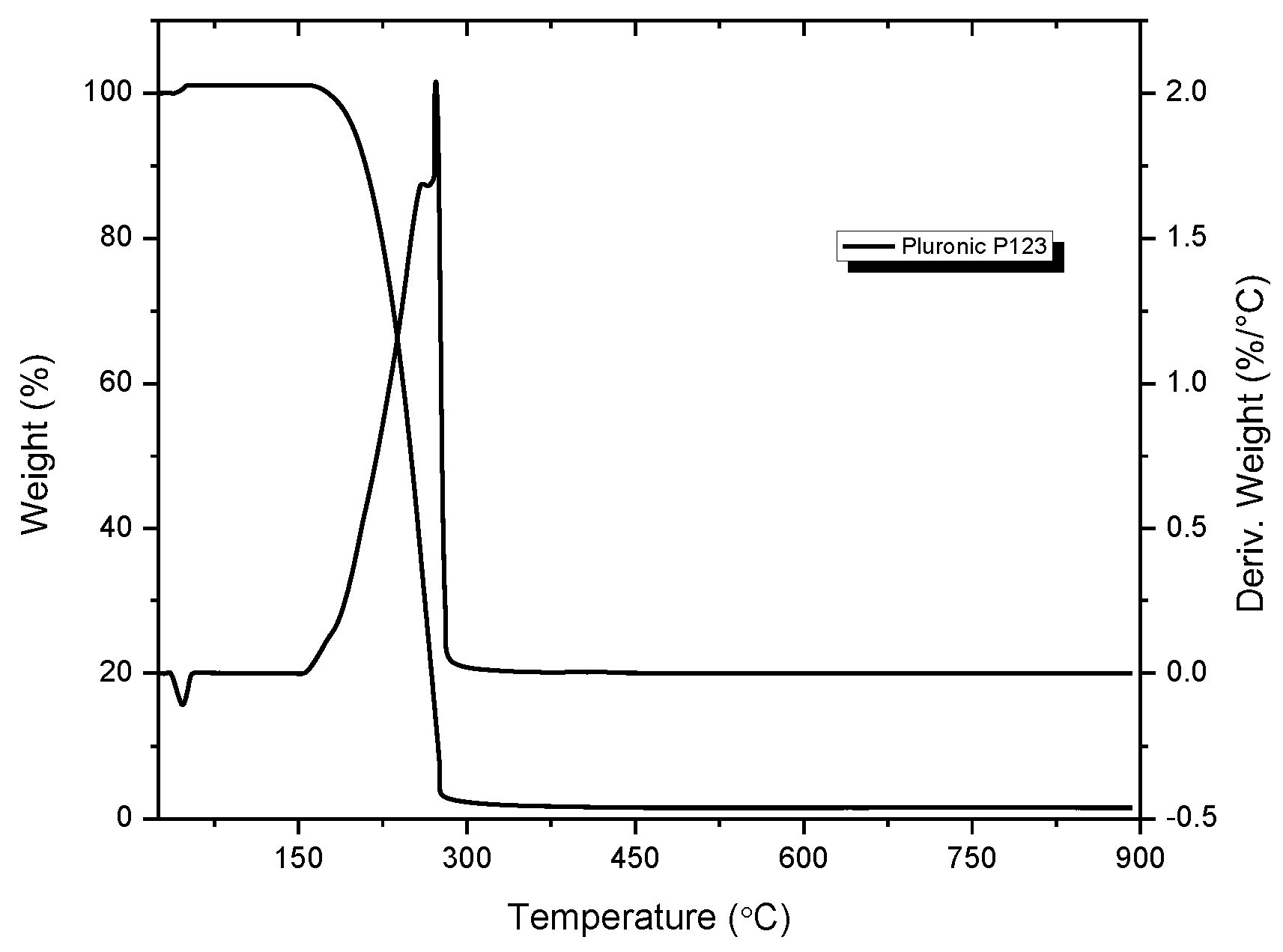
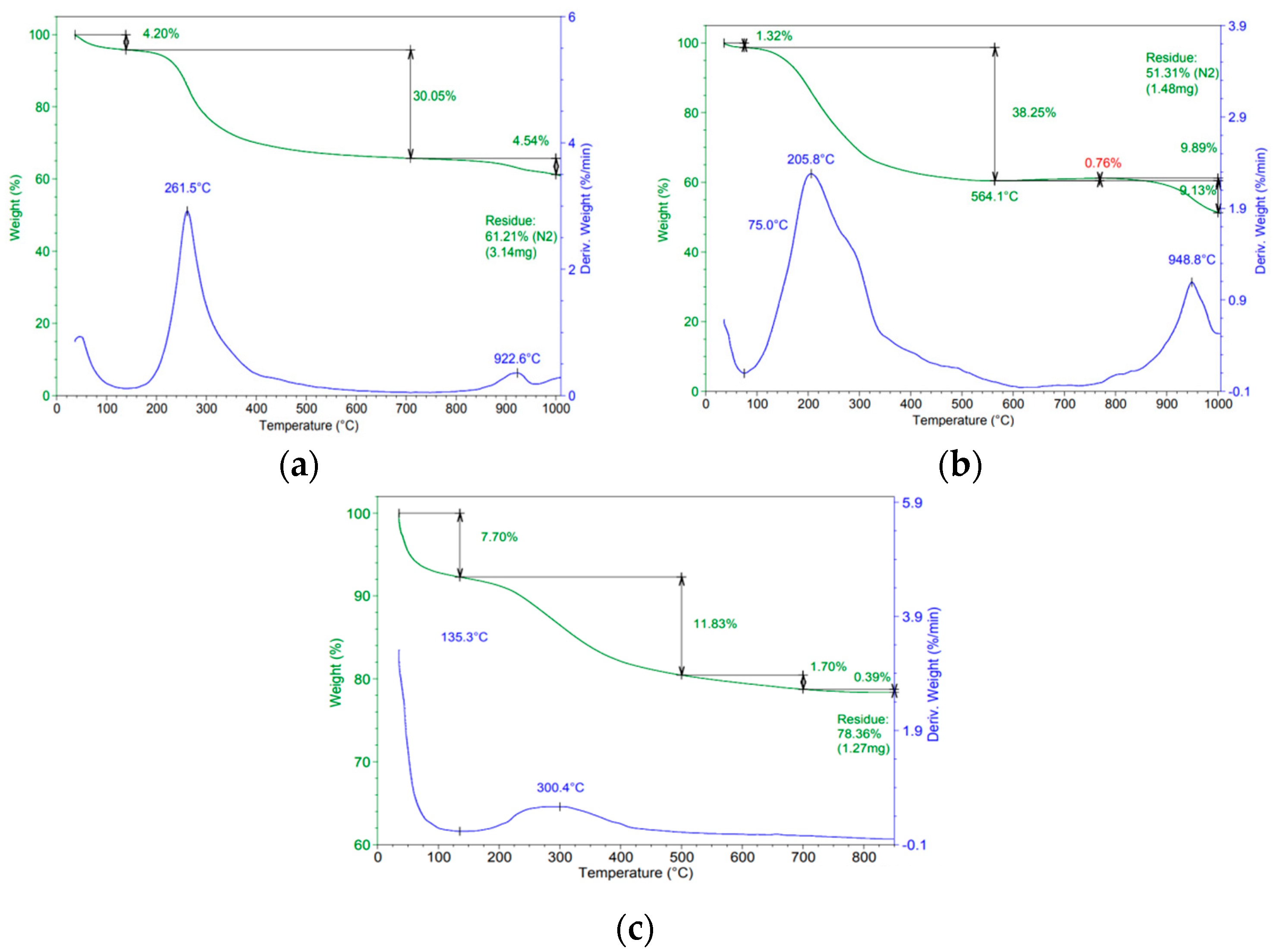
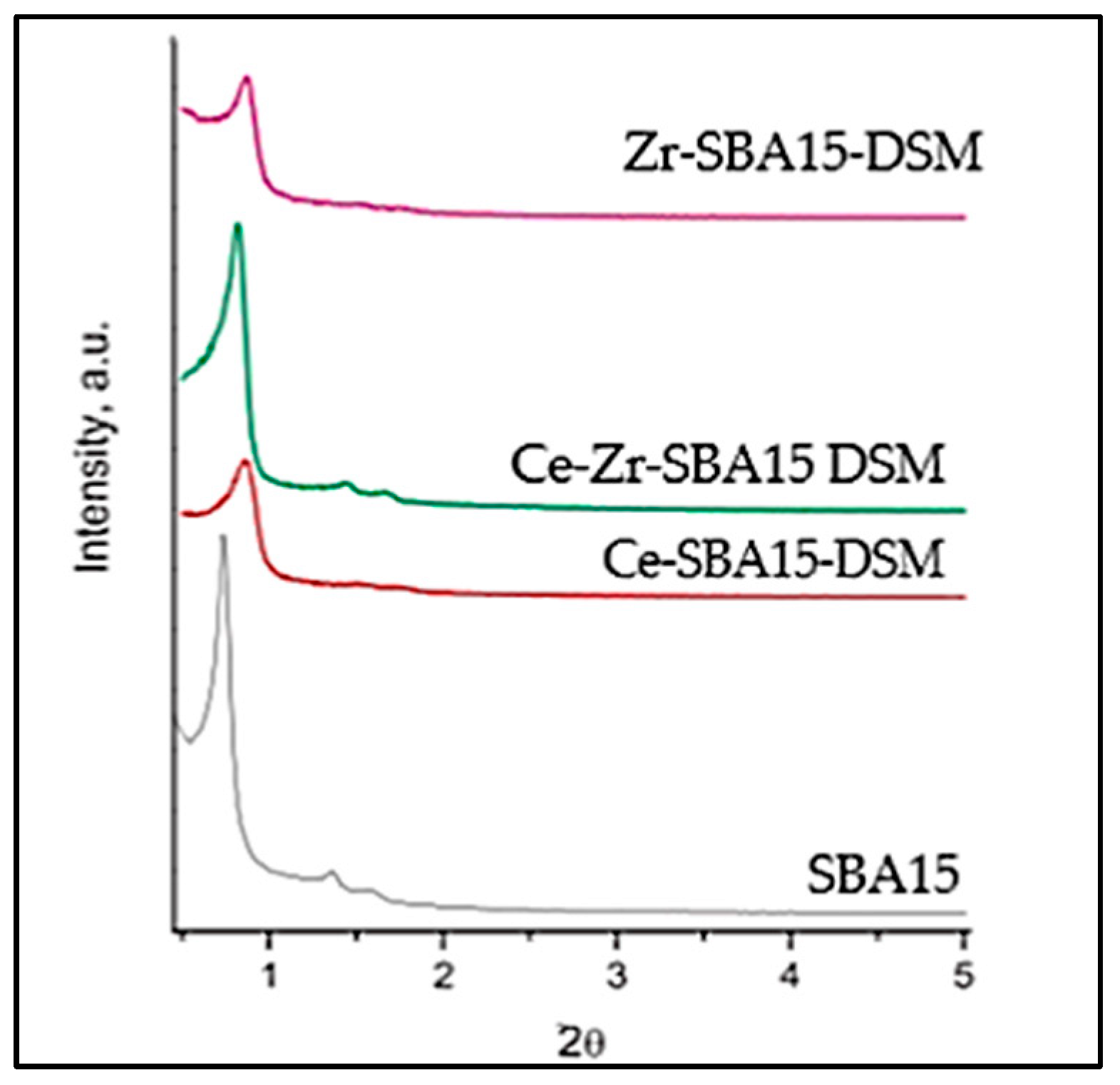
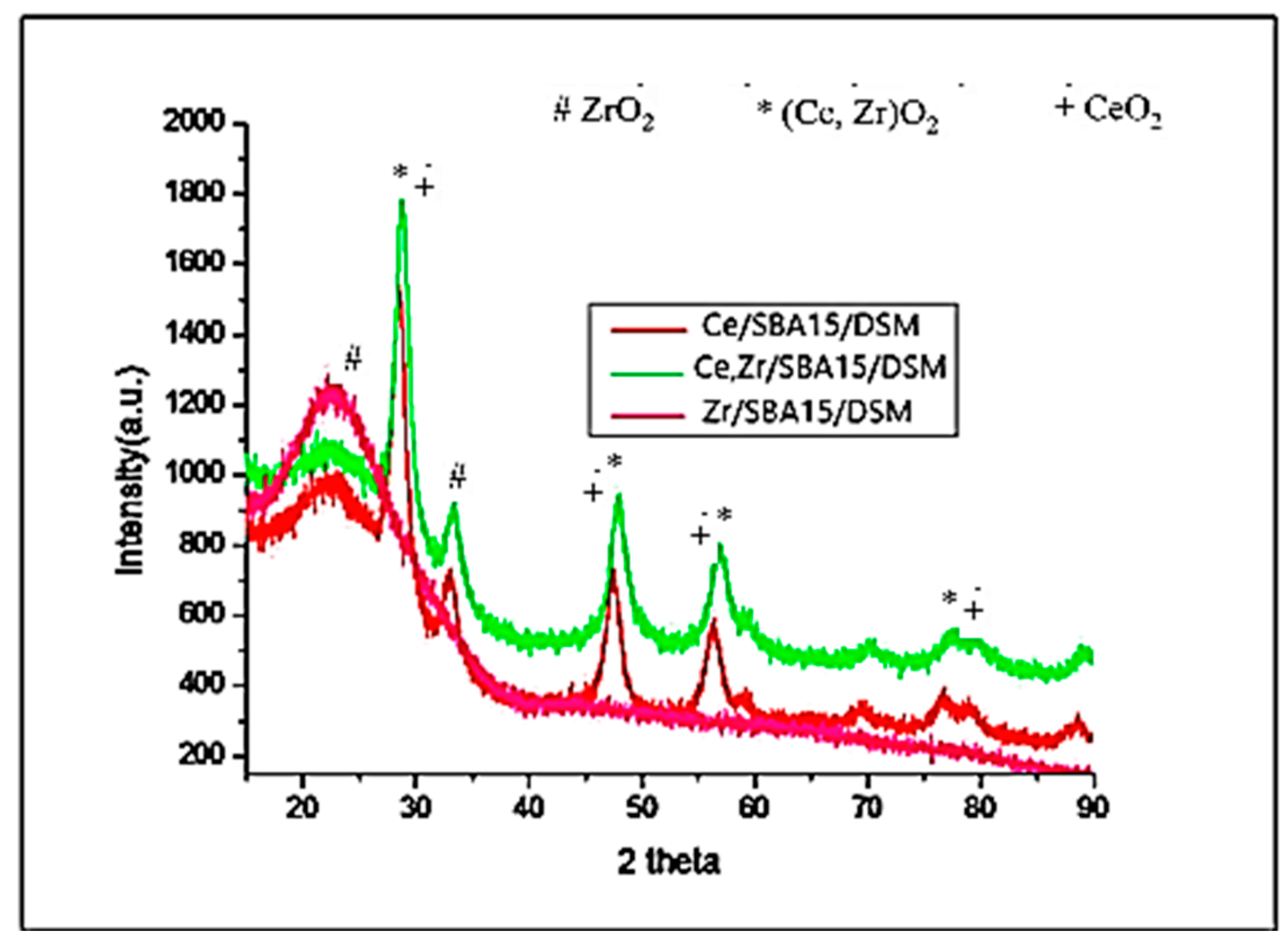
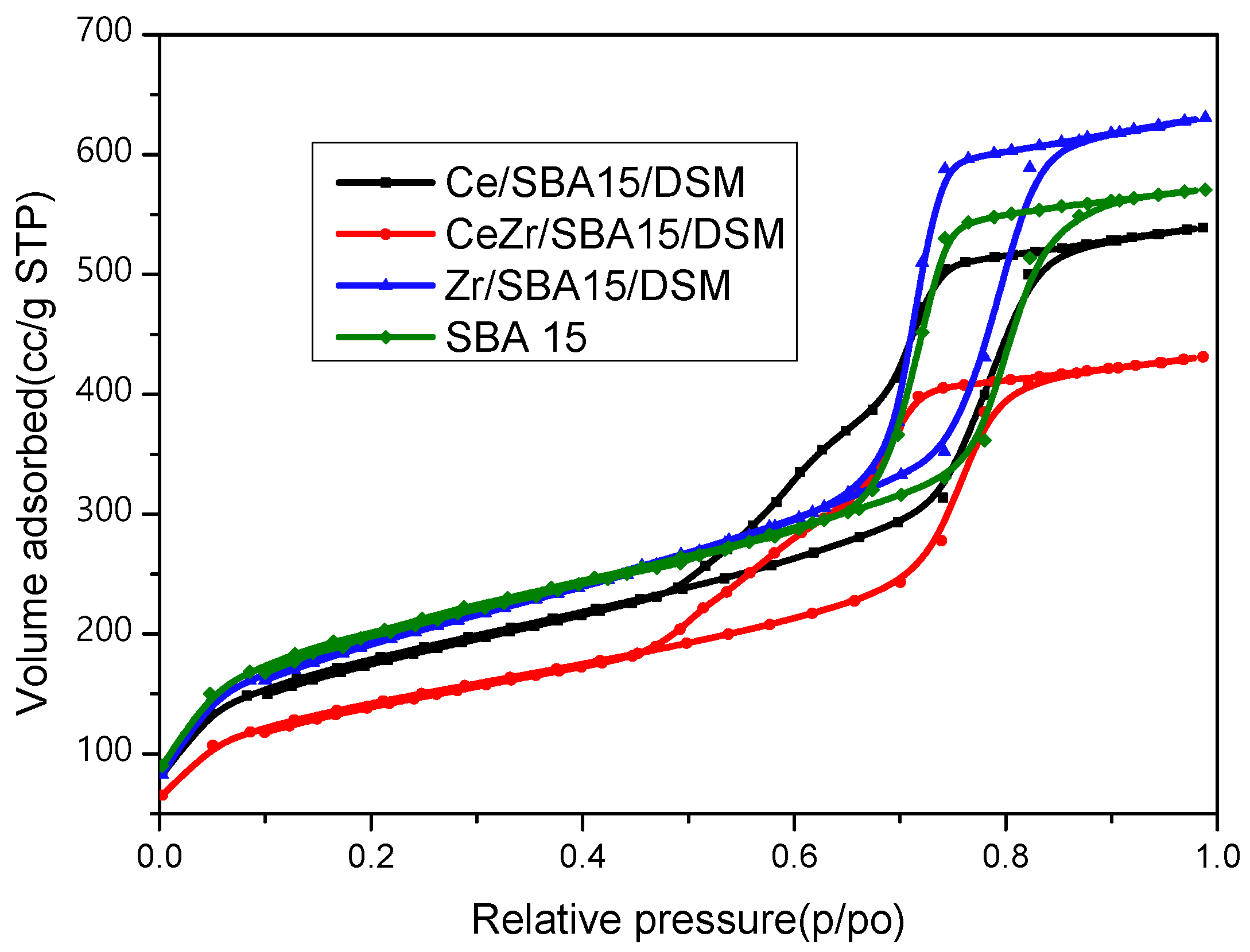
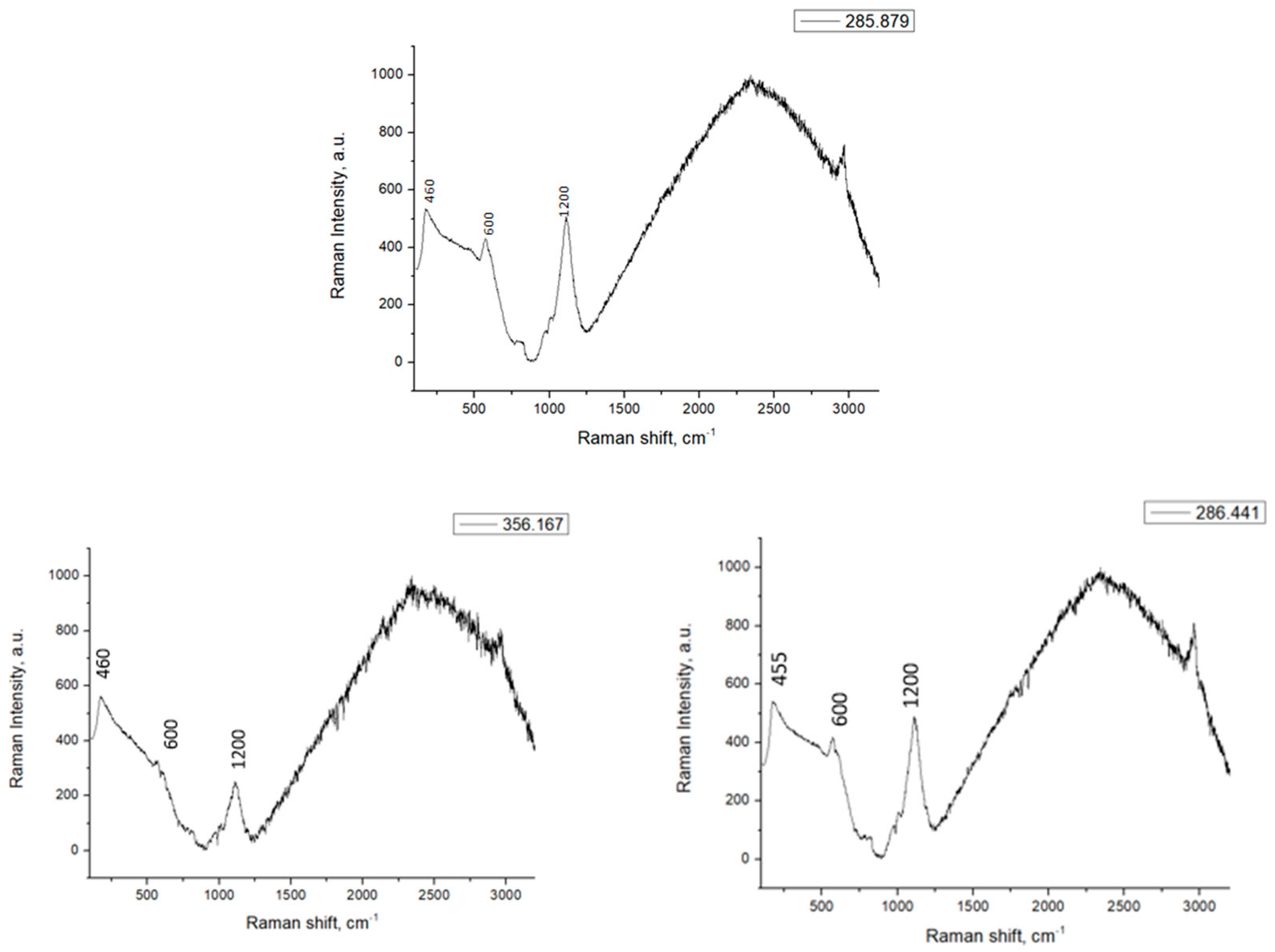
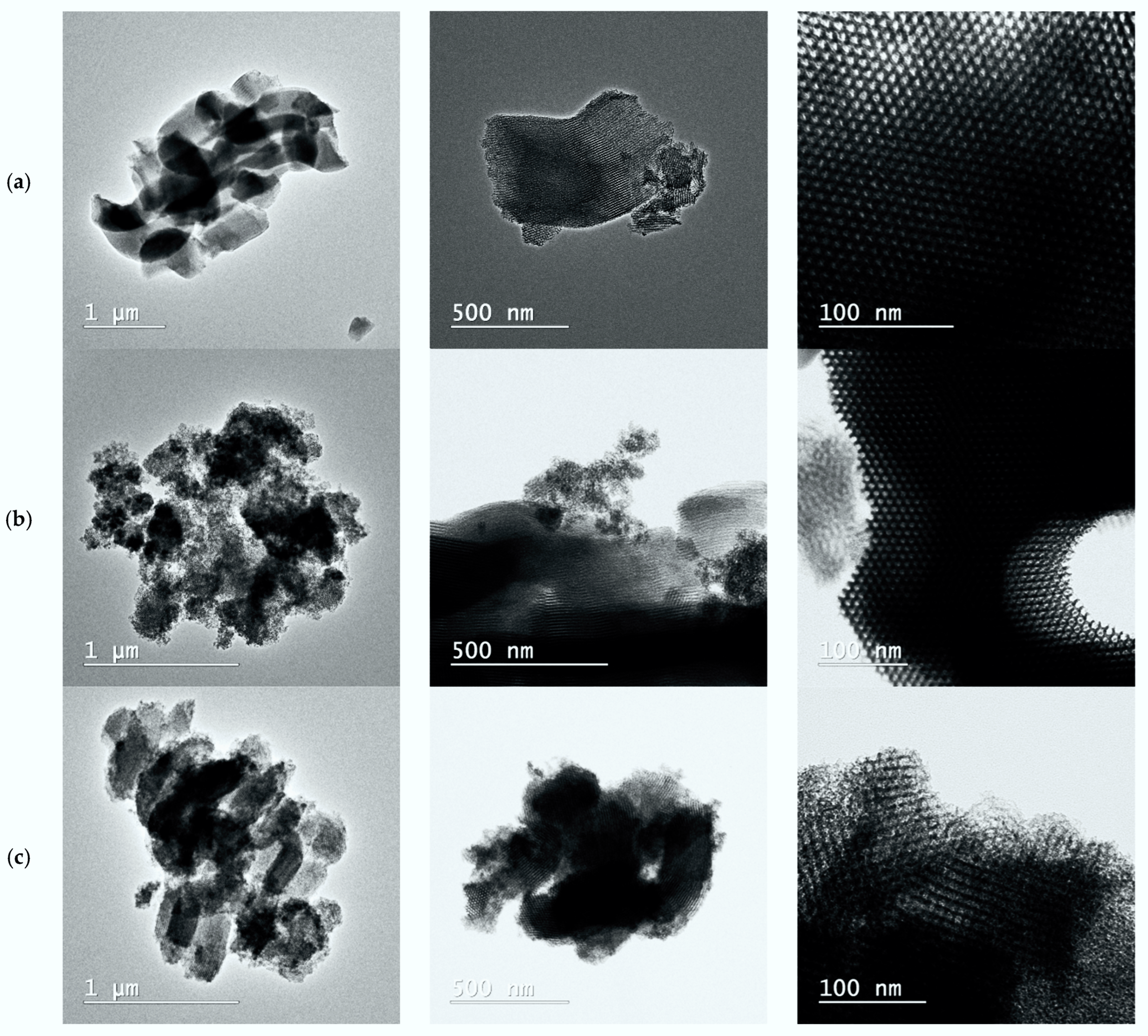
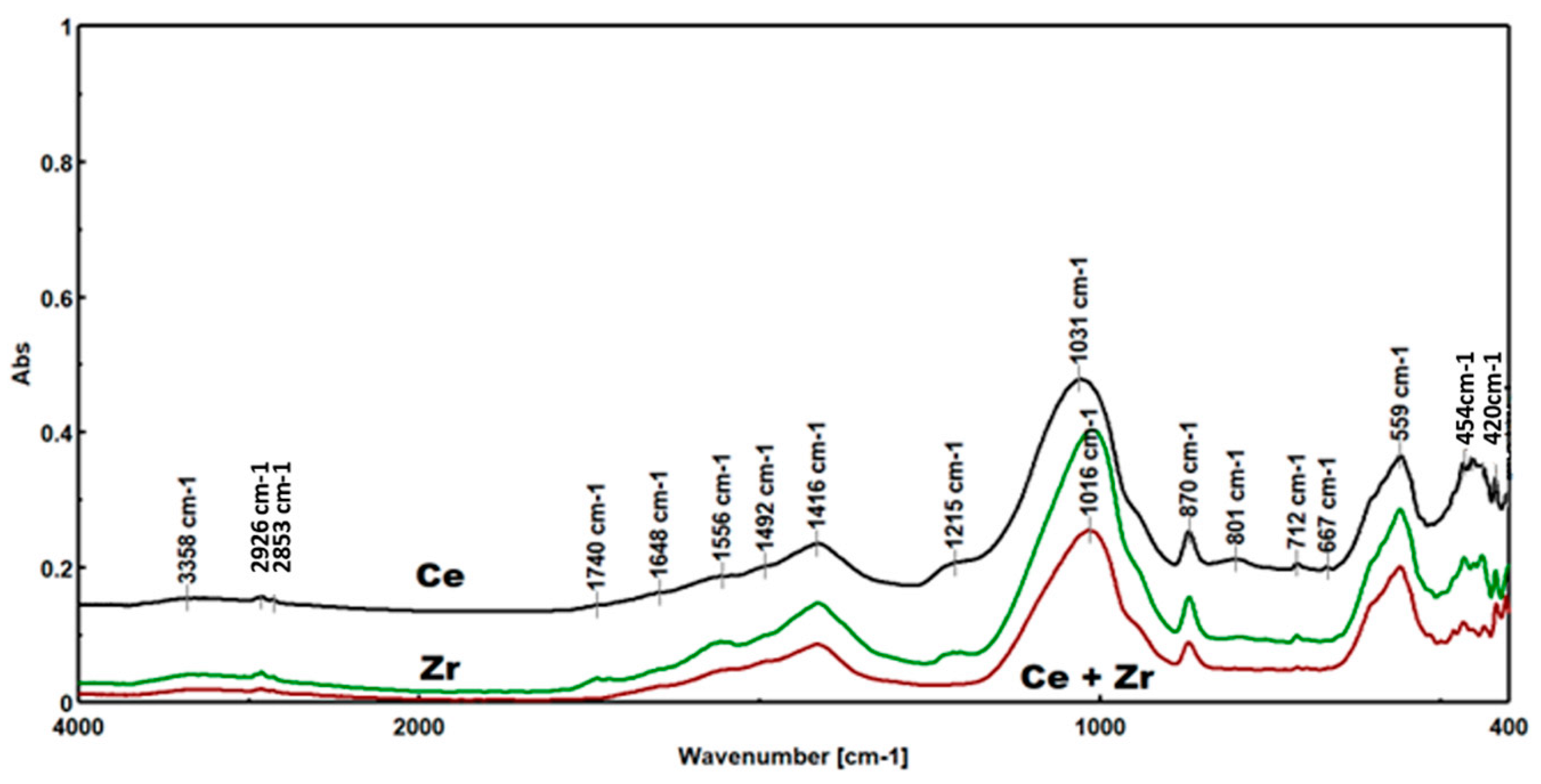
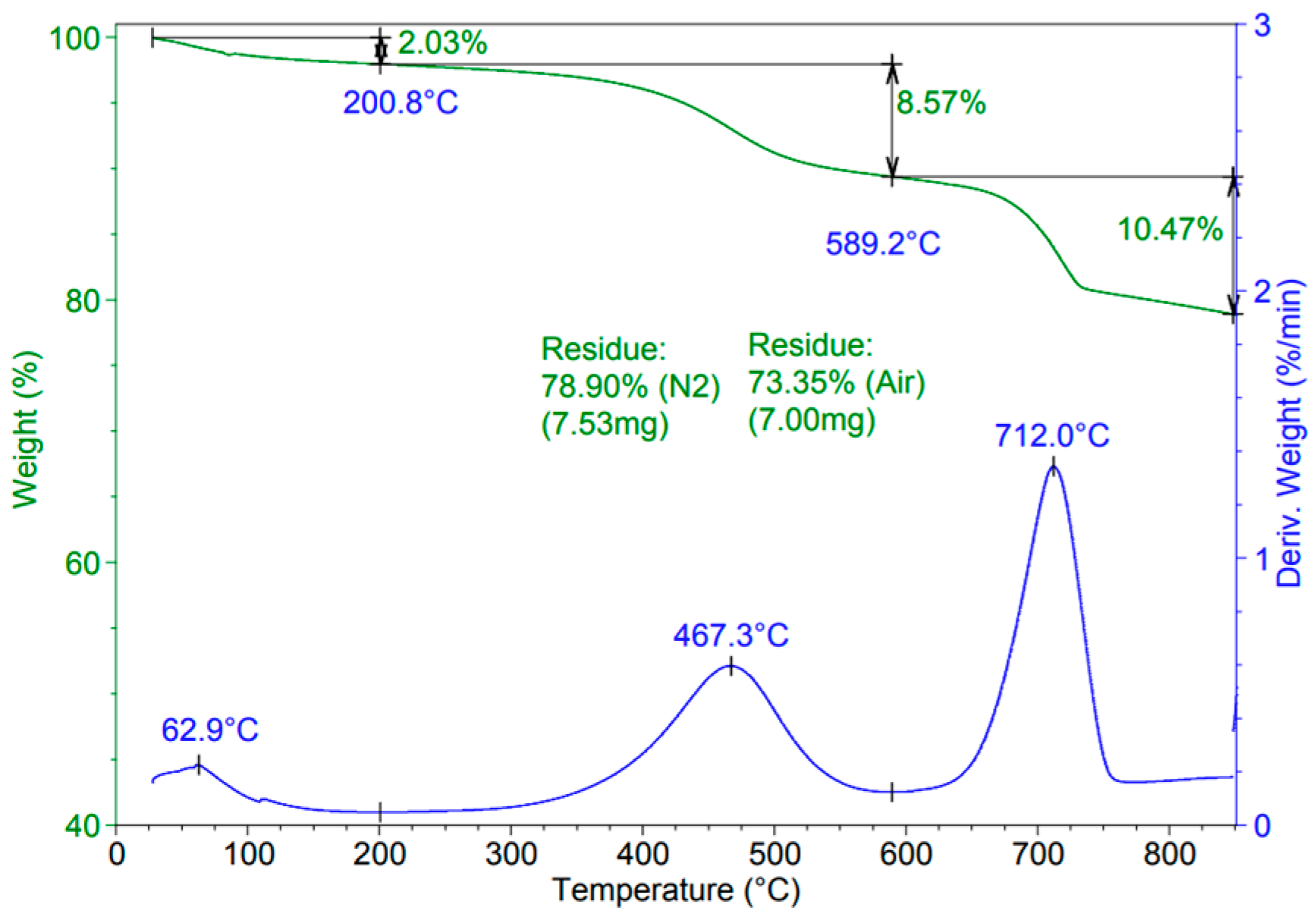
| Sample | SSA (m2/g) | Vp(cm3/g) |
|---|---|---|
| SBA 15 | 734 | 1.24 |
| Ce/SBA15/DSM | 503 | 0.75 |
| Zr/SBA15/DSM | 483 | 0.85 |
| Ce-Zr/SBA15/DSM | 446 | 0.62 |
| Peak Number | RT | Substance | Concentration % | Concentration % | Concentration % |
|---|---|---|---|---|---|
| 1 | 8.926 | Furfuryl alcohol | 7 | 6.5 | 6.75 |
| 2 | 11.192 | Phenol, 2-methoxy | 4.02 | 3.25 | 4.08 |
| 3 | 13.41 | p-Cresol | 16.75 | 16.5 | 16 |
| 4 | 14.559 | Palmitic acid, methyl ester | 5 | 4.5 | 5.5 |
| 5 | 14.615 | 9-Hexadecenoic acid, methyl ester | 8.75 | 7.75 | 8.5 |
| 6 | 15.149 | Phenol, 2,6-dimethoxy-ester | 4.25 | 4.5 | 4.6 |
| 7 | 16.625 | 11-Octadecenoic acid, methyl ester | 25 | 24.75 | 22 |
| 8 | 16.769 | Indole | 8.25 | 7.75 | 7.5 |
| 9 | 17.024 | Methyl 10-trans,12-cis-octadecadienoate | 3.75 | 4 | 3.5 |
| Peak Number | RT | Substance | Concentration % | Concentration % | Concentration % |
|---|---|---|---|---|---|
| 1 | 8.926 | Furfuryl alcohol | 2.85 | 2.85 | 2.85 |
| 2 | 12.636 | Tetradecanoic acid, methyl ester | 5.42 | 5.42 | 5.42 |
| 3 | 13.952 | Decyl ether | 3.42 | 3.42 | 3.42 |
| 4 | 14.622 | Palmitic acid, methyl ester | 19.7 | 19.7 | 19.7 |
| 5 | 14.87 | 9-Hexadecenoic acid, methyl ester | 7.42 | 7.42 | 7.42 |
| 6 | 16.434 | Stearic acid, methyl ester | 6 | 6 | 6 |
| 7 | 16.633 | 9-Octadecenoic acid, methyl ester | 4.07 | 4.07 | 4.07 |
| 8 | 16.681 | 11-Octadecenoic acid, methyl ester | 4 | 4 | 4 |
| 9 | 16.896 | Linoleic acid, methyl ester | 2.3 | 2.3 | 2.3 |
| 10 | 17.032 | Oleic acid, ethyl ester | 14.5 | 14.5 | 14.5 |
| 11 | 17.112 | 6-Octadecenoic acid | 6.57 | 6.57 | 6.57 |
| 12 | 17.583 | Linolenic acid, methyl ester | 4.85 | 4.85 | 4.85 |
| Peak Number | RT | Substance | Concentration % | Concentration % | Concentration % |
|---|---|---|---|---|---|
| 1 | 8.926 | Furfuryl alcohol | 4.75 | 4 | 4.5 |
| 2 | 10.457 | 1-Dodecanol, 3,7,11-trimethyl-ester | 5.08 | 5 | 5.25 |
| 3 | 12.668 | Phenol | 11.5 | 11 | 11.8 |
| 4 | 13.41 | p-Cresol | 10.75 | 10.5 | 11 |
| 5 | 14.614 | Palmitic acid, methyl ester | 16.25 | 16.5 | 16.75 |
| 6 | 14.862 | 9-Hexadecenoic acid, methyl ester | 6.02 | 5.75 | 5.5 |
| 7 | 16.434 | Stearic acid, methyl ester | 5.75 | 6 | 5.5 |
| 8 | 16.625 | 11-Octadecenoic acid, methyl ester | 25 | 24.75 | 25 |
| 9 | 17.024 | Linoleic acid, methyl ester | 11 | 10 | 10.75 |
| Peak Number | RT | Area | Concentration % | Concentration % | Concentration % |
|---|---|---|---|---|---|
| 1 | 4.434 | Methylpyrazine | 18 | 17 | 18 |
| 2 | 5.04 | Pyrazine, 2,6-dimethyl- | 20 | 20 | 19.6 |
| 3 | 5.742 | 2-Ethyl-6-methylpyrazine | 8.8 | 8.6 | 8.8 |
| 4 | 5.974 | 3-Pyridinamine, 2,6-dimethyl-ester | 5.2 | 5.3 | 5.6 |
| 5 | 6.428 | 2-Ethyl-3,6-dimethylpyrazine | 3 | 3 | 2.9 |
| 6 | 8.926 | Furfuryl alcohol | 5.4 | 5.2 | 5.4 |
| 7 | 12.668 | Phenol | 12 | 12 | 11.8 |
| 8 | 13.426 | p-Cresol | 6.4 | 6.6 | 6.4 |
| 9 | 14.04 | 2-Piperidinone | 13.6 | 13.2 | 13.6 |
| 10 | 16.617 | 11-Octadecenoic acid, methyl ester | 5 | 4.6 | 5 |
Disclaimer/Publisher’s Note: The statements, opinions and data contained in all publications are solely those of the individual author(s) and contributor(s) and not of MDPI and/or the editor(s). MDPI and/or the editor(s) disclaim responsibility for any injury to people or property resulting from any ideas, methods, instructions or products referred to in the content. |
© 2024 by the authors. Licensee MDPI, Basel, Switzerland. This article is an open access article distributed under the terms and conditions of the Creative Commons Attribution (CC BY) license (https://creativecommons.org/licenses/by/4.0/).
Share and Cite
Ghimiș, S.-B.; Oancea, F.; Raduly, M.-F.; Mîrț, A.-L.; Trică, B.; Cîlțea-Udrescu, M.; Vasilievici, G. Direct Hydrothermal Synthesis and Characterization of Zr–Ce-Incorporated SBA-15 Catalysts for the Pyrolysis Reaction of Algal Biomass. Energies 2024, 17, 3765. https://doi.org/10.3390/en17153765
Ghimiș S-B, Oancea F, Raduly M-F, Mîrț A-L, Trică B, Cîlțea-Udrescu M, Vasilievici G. Direct Hydrothermal Synthesis and Characterization of Zr–Ce-Incorporated SBA-15 Catalysts for the Pyrolysis Reaction of Algal Biomass. Energies. 2024; 17(15):3765. https://doi.org/10.3390/en17153765
Chicago/Turabian StyleGhimiș, Simona-Bianca, Florin Oancea, Monica-Florentina Raduly, Andreea-Luiza Mîrț, Bogdan Trică, Mihaela Cîlțea-Udrescu, and Gabriel Vasilievici. 2024. "Direct Hydrothermal Synthesis and Characterization of Zr–Ce-Incorporated SBA-15 Catalysts for the Pyrolysis Reaction of Algal Biomass" Energies 17, no. 15: 3765. https://doi.org/10.3390/en17153765







